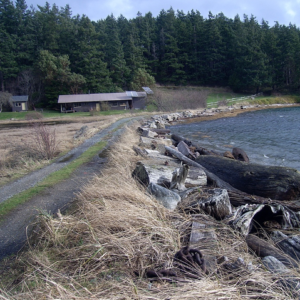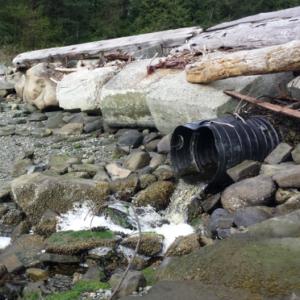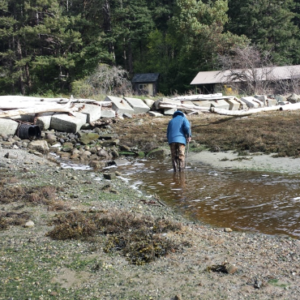Almost seven years ago, Friends of the San Juans began working with Washington State Parks on a salmon recovery project on Sucia Island. After a lot of research, surveys, designs, engineering, and permitting, the on-the-ground work to restore habitat is finally happening this month!

Located along a major migratory pathway for juvenile salmon, Sucia is ranked within the top 3% of San Juan County’s marine shorelines for salmon recovery efforts. Plus, Sucia’s Mud Bay includes a 2.2-acre salt marsh, providing very rare and valuable shoreline habitat for juvenile salmon and forage fish.
Unfortunately, many decades before many understood how important these habitats are to the Salish Sea, structures were built on Sucia Island that profoundly damaged the shoreline ecosystem. Specifically, at the place where the salt marsh and beach meet at Mud Bay, there is a 300-foot, low-lying causeway (road, fill, and culvert) that has impacted salmon recovery in multiple ways. The road and culvert are a tidal barrier that limits the many habitat benefits that estuarine wetlands provide to juvenile salmon. The shoreline armoring directly covers and degrades important spawning habitat for forage fish. Lastly, the road prevents the beach and wetland from adjusting to rising sea levels, further reducing coastal habitats and ecosystem functions.

The goal of this collaborative project is to restore the salt marsh, tidal channel, and beach habitats in Mud Bay, which will directly support both migrating juvenile salmon and critical forage fish. To achieve this goal, the entire low-lying causeway will be removed to return the beach, marsh and tide channel to more natural conditions. Working with the San Juan Islands Conservation Corps, we will then replant the area with native plants. To allow for this full restoration option, we will install a new access road at the back of the marsh that has as little impact as possible on the ecosystems to connect the Parks maintenance buildings with the existing road.
Stay tuned to the Friends of the San Juans Facebook and Instagram pages, where we will post photos of the project in action over the next few weeks.
After a formal bidding process, the public works contract was awarded to Mike Carlson Enterprises of San Juan Island, who is working with additional local contractors including Rain Shadow Consulting of Orcas Island. The restoration design and engineering were completed by Coastal Geologic Services of Bellingham. The San Juan Islands Conservation Corps will help with the revegetation work later in October.

Grant funding was provided from multiple sources: Washington Salmon Recovery Funding Board, Estuary and Salmon Restoration Program, Department of Ecology Coastal Protection Fund, and the U.S. Fish & Wildlife Service. Washington State Parks, project partner from the beginning, is providing in-kind assistance.
Photo at top: Mud Bay Salt Marsh on Sucia Island, by Caldera Archeology
